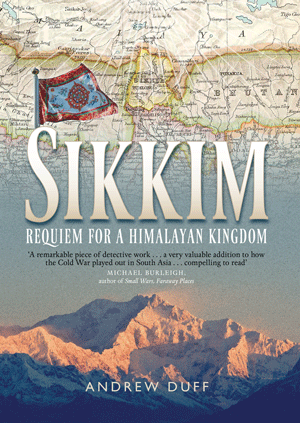“But what if,” I ask, “I wanted to become Indian?”
It is 9am, and we are twelve hours into a seventeen-hour train journey. There is something about Indian trains that encourages social intercourse, and I have succumbed to the temptation to engage in debate with my fellow passengers.
“You know,” I continue. “Like when Indians come to Britain. They get British nationality – why shouldn’t I be able to get Indian nationality?”
The smiles become fixed. Perhaps I have gone too far, lulled into a false sense of security by the inevitable intimacy of the overnight journey. But it feels like we six, who had never met this time yesterday, have now become firm friends as we shed sandals and inhibitions while chai-wallahs dispense their sweet sickly tea and Indian Railways staff dispense paratha and curry for breakfast.
I am intimidated by the silence in response to my question and break it once more.
“Because how I see it, there could be economic migration the other way soon. Quite a lot of people don’t want to be European these days. What do you think?” I ask, trying to push the issue.
The chatty bare-footed and cross-legged Marwari trader opposite me smiles.
“Maybe that will happen in say, 100 years, but not now.”
He’s probably right. It recall the comment by a Wen Jiaboa a few years ago when asked if democracy might come to China. His response: “Yes, but it will take 100 years.” (I paraphrase). These are big challenges for the Western world right now. As Europe and America struggle with reassessing their position in a globalized world, the massive nations of India and China take their own path. Self-evidently, “globalization” will not mean that everyone adopts a Western approach. Rather governments of countries on a rapid growth path will pick, and will more often be in a position to pick, how they deal with the West.
After all, migration is rarely a response to pressure from migrants coming in. It’s far more often a solution to an inherent workforce problem. And if there’s one thing India is not lacking it’s a ready and willing workforce.
Despite the lack of verbal traffic, I realize that the channels of conversation are now firmly open so I try another tack.
“How about Mamata, then?” Mamata Bannerjee is the extraordinary Chief Minister of West Bengal who ended 30-odd years of communist rule in the state and is still riding high in the poles.
“Too early to tell,” was the response from the Marathi trader.
His brother was less reticent. “She is very dashing, very adamant, very dashing indeed,” he says.
Wait a minute, I think – “dashing”? Do they mean that they like the cut of her crumpled white sari? What is this? I probe further.
No, it transpires, what they mean is that she is working quickly, that she isn’t fond of taking into account other people’s opinions. It’s interesting, this. They’re not criticizing her, but they are accepting that perhaps her speed may define her, that it makes her stand out in a crowd of inactive politicians.
What’s most interesting is that she seems to be a politician of action in office, not just in getting to office. And she also seems to have a vision for Calcutta, the capital of the state, once (until 1911) the Imperial capital of all India and the “second city of the Empire”. Everywhere in Calcutta, trident style traffic lights are appearing of the sort that existed here before Independence in 1947. The roads seem cleaner, smarter. There is an attempt to create a new riverfront walk.
Later, in Calcutta, I spoke to Mr Sen, the man in charge of the works at the Royal Calcutta Turf Club building on Russell Street. The RCTC retains the building but Emaar Group (responsible for the Burj in Dubai) is restoring the building and turning it into a luxury hotel for the Hyatt chain. According to him, Mamata is tightening up on restoration work. Everything must be returned to its original state.
If this is indeed what is happening, it is welcome indeed. For decades, heritage buildings in Calcutta have been bastardised with modern add-ons. I’ve often thought that it’s better to pull a building down that end up with mish-mash of styles.
These are developments to watch. If Calcutta can recapture some of its old glory in its centre while building an economic base in its sparling suburbs it could once again become quite a city. There is a long way to go, but if Mamata is the woman of action she appears to be, then I’m on her side. At least Calcuttans will know sooner rather than later.
Gods…
Back on the train, conversation moves on. My new-found friends ask me what brought me to India. I explain about the Jaipur Literature Festival. They have all heard about the Rushdie affair.
I tell them about the final debate. Do they think that “Man has replaced God’, the provocative question asked by the organisers?
“There is always very much debates,” a well-dressed man in slacks and shirt answers in an evasive way.
The Marari trader’s brother chips in. “God is one, my friend…” he says with a sparkle in his eye. “God is one. In India we have five sects – Hindu, Mohammedan, Chistian, Buddhist, and…”
The fifth escapes him for a moment. I suggest Jewish? No. Sikhs, he replies. All worshipping the same God.
It is a particularly inclusive and all-embracing Hindu approach. It seems deeply practical to the Hindu; it doesn’t seem quite so simple to other faiths. Maybe that’s the genius of the Hindu approach. Or maybe it’s just a cop-out. Time will tell.
There is certainly no indication that any of my middle-class fellow passengers – even the two monotheistic Bengali Muslims – even entertain the notion that division and separation benefit anybody.
… And plastics
There is a lull in conversation. I turn to my book. I can still overhear the conversation, which now turns to the reason they are all on the train.
Last week, PlastIndia 2012 brought manufacturers, wholesalers and retailers of plastics rushing towards Delhi. The conversation switches effortlessly to Hindi and is suddenly earnest. English words – “lamination”, “plastic samples”, “double-mould” – pepper the discussion as glossly leaflets announcing this or that extrusion process are proudly passed around, along with examples of materials.
A young man in his early thirties in a shiny two-tone blue striped shirt turns to me. “Plastics is the future! Plastics is the future! Plastics is the future!” he tells me excitedly.
I think of the advice to a young Dustin Hoffman in the film ‘The Graduate’: “I just want to say one word to you – one word – plastics.” Is it still the future, 30 years on?
And then everything falls into place. Plastics. God. Nations. Someone somewhere has linked all these together before… I rack my brains.
Yes, American comedian George Carlin, that’s who. Click here to watch the video. It’s worth it, I promise. The message: Don’t worry. Be happy.



